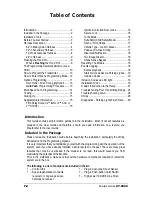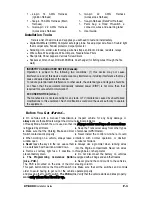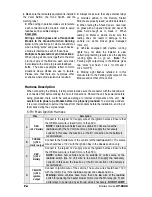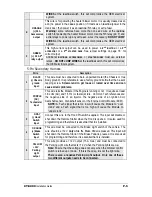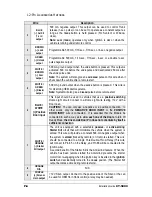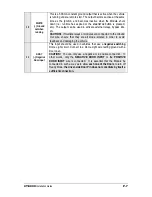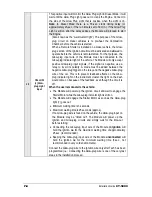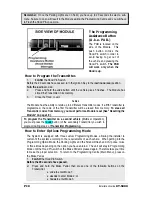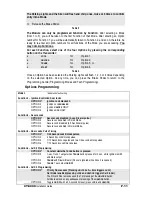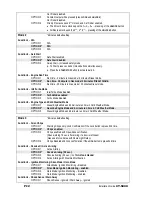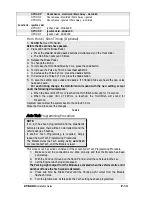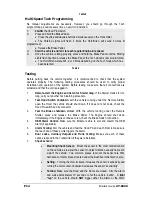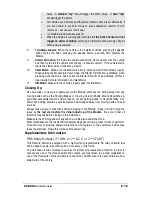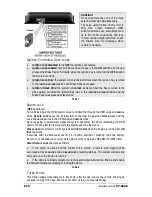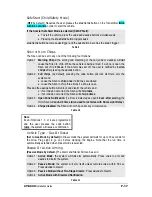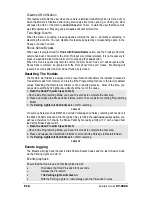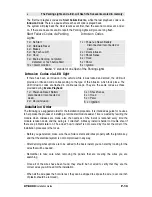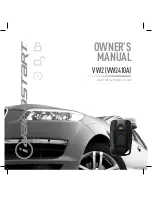
P.4
Installation
Guide
CT-5000
♦
Make sure that all safety equipment is installed:
the Valet Button, the Hood Switch and the
warning label
♦
When wiring in parallel, make sure to isolate
each connection with a diode in order to avoid
feedback and possible damage.
Examples:
Wiring a clutch bypass and a Transponder
Module to the Ground Out when Running
wire:
At the junction point, where Ground Out
when running “splits” and goes to each device,
a diode is inserted on each of those lines.
Multiple or Separate Door pin Connections:
When joining all door pins together to the Door
pin input wire of the Module, each wire must
be isolated with a diode to prevent feedback.
N.B.:
The above examples reflect common
situations where diodes are use to isolate.
Please note that there are numerous other
scenarios where diode isolation is required.
♦
Always make sure that any external relays
or modules added to the Remote Starter
Module are properly fused, and diode isolated.
♦
When testing the Shock Sensor, never test
on glass with an opened hand, and never hit
glass hard enough as to break it. When
testing on Metal or plastic, make sure the
testing does not result in damage to the
vehicle (i.e.: dents, broken glass, damaged
trims, etc.).
♦
Vehicles equipped with daytime running
lights may not allow the installer to view
certain programming results since the daytime
running lights do no go out (
Note:
The
Parking Light output relay in the Module gives
two “
clicks”
per flash, 1
click
for ON and 1
click
for OFF).
♦
Parking Light flashes referred to in this
manual refer to the Parking Light output of the
Module and not that of the vehicle.
Harness Description
When connecting the Module, it is important to make sure the connector with the Ground wire
is connected first before making the 12-volt connections. Should the unit be powered before
being grounded, there could be serious damage to internal components of the unit.
Be
careful not to power up a Module before it is properly grounded.
To avoid any accident,
it is a recommended to pull out the fuses from their sockets before the installation, and to put
them back during the very last steps.
6-Pin Main Ignition Harness
Wire
Description
A
RED
+12 V Battery
Connect to the largest 12 V supply wire at the Ignition harness. Ensure that
the OEM power wire is fused for more than 30 A.
NOTE:
certain new vehicles have no suitable 12 volts source at the
IGNITION
switch (the 12 Volt wire is too small to supply the necessary
current). In this case, the fuse box, or the B+ connection on the battery is
recommended.
B
PURPLE
(+) 30 A
starter output
Connect to the Starter wire of the vehicle (at the
IGNITION
switch). The source
wire should have +12 V with the Ignition Key in the
CRANK
position only.
C
RED
(+) 12 V
Battery
Connect to the largest 12 V supply wire at the Ignition harness. Ensure that
the OEM power wire is fused for more than 30 A.
NOTE:
certain new vehicles have no suitable 12 volts source at the
IGNITION
switch (the 12 Volt wire is too small to supply the necessary
current). In this case, the fuse box, or the B+ connection on the battery is
recommended.
D
YELLOW
(+) 30 A
ignition
output
Connect to Ignition wire of the vehicle. The source wire should have +12 V
with the Ignition Key in the
IGNITION ON
(
RUN
) and
CRANK
positions.
Warning:
some vehicles have more than one
IGN
wire at the
IGNITION
switch for powering the heater blower motor. Use the 5th relay (pin F) and
extra relays to power up any extra
IGN
. wires if necessary.
DO NOT JUMP


